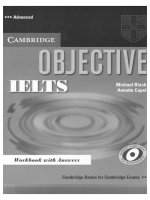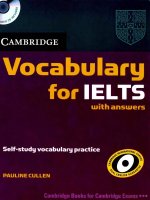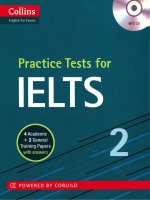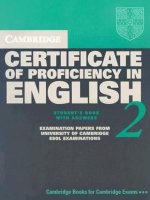101 IELTS reading past papers with answers 2019 by IELTSMaterial publishing
Bạn đang xem bản rút gọn của tài liệu. Xem và tải ngay bản đầy đủ của tài liệu tại đây (7.98 MB, 496 trang )
TableofContents
ReadingTest1
Section1
AndreaPalladio:Italianarchitect
Section2
Thefutureneverdies?
Section3
PotteryproductioninancientAkrotiri
ReadingTest2
Section1
SavetheTurtles
Section2
CorporateSocialResponsibility
Section3
TVAddiction2
ReadingTest3
Section1
Timekeeper2InventionofMarineChronometer
Section2
Fatherofmodernmanagement
Section3
Extinct:theGiantDeer
ReadingTest4
Section1
NewAgricultureinOregon,US
Section2
IntelligenceandGiftedness
Section3
PaperorComputer?
ReadingTest5
Section1
TerminatedDinosaurEra
Section2
DetectionofameteoriteLake
Section3
InternalandExternalMarketing
ReadingTest6
Section1
OTTER
Section2
BIRDMIGRATION2
Section3
TalcPowder
ReadingTest7
Section1
TheDinosaursFootprintsandExtinction
Section2
WHATCOOKBOOKSREALLYTEACHUS
Section3
Learninglessonsfromthepast
ReadingTest8
Section1
FinchesonIslands
Section2
Flightfromreality?
Section3
CommunicatingConflict!
ReadingTest9
Section1
AgricultureandTourism
Section2
CosmeticsinAncientPast
Section3
AsianSpace2SatelliteTechnology
ReadingTest10
Section1
Koalas
Section2
Antarctica-infromthecold?
Section3
LanguagestrategyInMultinationalCompany
ReadingTest11
Section1
THEORIGINOFWRITING
Section2
Aquaproduct:NewZealand’sIgaeBiodiesel
Section3
BritishArchitecture2
ReadingTest12
Section1
RadioAutomationforerunneroftheintegratedcircuit
Section2
BestcomCONSIPERATECOMPUTING
Section3
Environmentally-friendly!Vihicles
ReadingTest13
Section1
BondiBeach
Section2
HuntingPerfumeinMadagascar!
Section3
TheExplorationofMars
ReadingTest14
Section1
TraditionalFarmingSysteminAfrica
Section2
GriffithandAmericanfilms
Section3
ThePersuaders
ReadingTest15
Section1
TeaandIndustrialRevolution
Section2
Fossilfiles:"ThePaleobiologyDatabase"
Section3
Communicationinscience
ReadingTest16
Section1
CanWeHoldBacktheFlood?
Section2
WhentheTulipBubbleBurst
Section3
TheSecretsofPersuasion
ReadingTest17
Section1
MENTALGYMNASTICS
Section2
FindingOurWay
Section3
MysteryinEaster
ReadingTest18
Section1
TheMozartEffect
Section2
LondonSwayingFootbridge
Section3
BookreviewonMusiccophilia
ReadingTest19
Section1
Thecomingbackofthe“Extinct”GrassinBritain
Section2
CHILDREN’SLITERATURE
Section3
BeyondtheBlueLine
ReadingTest20
Section1
worldEcotourisminthedevelopingcourtiers
Section2
Memoryandage
Section3
ThesecretoftheYawn
ReadingTest21
Section1
ConsecutiveandSimultaneousTranslation
Section2
WaterFilter
Section3
Music:LanguageWeAllSpeak
ReadingTest22
Section1
Voyageofgoing:beyondtheblueline2
Section2
EuropeanHeatWave
Section3
theconceptofchildhoodinthewesterncountries
ReadingTest23
Section1
HaveTeenagersAlwaysExisted
Section2
Numeracy:cananimalstellnumbers?
Section3
Elephantcommunication
ReadingTest24
Section1
Ambergris
Section2
globalwarming:Preventpolesfrommelting
Section3
SunsetfortheOilBusiness
ReadingTest25
Section1
BuildaMedievalCastle
Section2
SmellandMemory:SMELLSLIKEYESTERDAY
Section3
MemoryDecoding
ReadingTest26
Section1
OriginofSpecies&ContinentFormation
Section2
ChineseYellowCitrusAntforBIOLOGICALCONTROL
Section3
MechanismsofLinguisticChange
ReadingTest27
Section1
MuseumBlockbuster
Section2
StressofWorkplace
Section3
CompanyInnovation
ReadingTest28
Section1
TheBeginningofFootball
Section2
ANewIceAge
Section3
Soviet’sNewWorkingWeek
ReadingTest29
Section1
DensityandCrowding
Section2
ThereconstructionofcommunityinTalbotPark,Auckland
Section3
VideoGame’sUnexpectedBenefitstoHumanBrain
ReadingTest30
Section1
LieDetector
Section2
Leaf-CuttingAntsandFungus
Section3
SaveEndangeredLanguage
ReadingTest31
Section1
Foodforthought2
Section2
SavingtheBritishBitterns
Section3
E-training
ReadingTest32
Section1
Animalminds:ParrotAlex
Section2
stealthForcesinweightLoss
Section3
BrightChildren
ReadingTest33
Section1
Section2
IsGraffitiArtorCrime?
Section3
Serendipity:TheAccidentalScientists
ReadingTest34
Section1
LONGAEVA:AncientBristleconePine
Section2
MonkeysandForests
Section3
AnswerKeys
ReadingTest1
ReadingTest2
ReadingTest3
ReadingTest4
ReadingTest5
ReadingTest6
ReadingTest7
ReadingTest8
ReadingTest9
ReadingTest10
ReadingTest11
ReadingTest12
ReadingTest13
ReadingTest14
ReadingTest15
ReadingTest16
ReadingTest17
ReadingTest18
ReadingTest19
ReadingTest20
ReadingTest21
ReadingTest22
ReadingTest23
ReadingTest24
ReadingTest25
ReadingTest26
ReadingTest27
ReadingTest28
ReadingTest29
ReadingTest30
ReadingTest31
ReadingTest32
ReadingTest33
ReadingTest34
ReadingTest1
Section1
AndreaPalladio:Italianarchitect
AnewexhibitioncelebratesPalladio’sarchitecture500yearson
A.Vicenzaisapleasant,prosperouscityintheVeneto,60kmwestofVenice.Its
grand families settled and farmed the area from the 16th century. But its
principalclaimtofameisAndreaPalladio,whoissuchaninfluentialarchitect
that a neoclassical style is known as Palladian. The city is a
permanent exhibition of some of his finest buildings, and as he was born—
inPadua,tobeprecise—500yearsago,theInternationalCentrefortheStudyof
Palladio's Architecture has an excellent excuse for mounting la
grandemostra,thebigshow.
B. The exhibition has the special advantage of being
heldinoneofPalladio'sbuildings,PalazzoBarbarandaPorto.Itsboldfacadeis
a mixture of rustication and decoration set between two rows of elegant
columns. On the second floor the pediments are alternately curved or pointed,
aPalladiantrademark.Theharmoniousproportionsoftheatriumattheentrance
lead through to a dramatic interior of fine fireplaces and painted ceilings.
Palladio's design is simple, clear and not over-crowded. The show has been
organisedonthesameprinciples,accordingtoHowardBurns,thearchitectural
historianwhoco-curatedit.
C. Palladio's father was a miller who settled in
Vicenza,wheretheyoungAndreawasapprenticedtoaskilledstonemason.How
didahumblemiller'ssonbecomeaworldrenownedarchitect?Theanswerinthe
exhibition is that, as a young man, Palladio excelled at carving decorative
stonework on columns, doorways and fireplaces. He was plainly intelligent,
and lucky enough to come across a rich patron, Gian Giorgio Trissino, a
landownerandscholar,whoorganisedhiseducation,takinghimtoRomeinthe
1540s, where he studied the masterpieces of classical Roman and
Greekarchitectureandtheworkofotherinfluentialarchitectsofthetime,such
asDonatoBramanteandRaphael.
D. Burns argues that social mobility was also important.
Entrepreneurs, prosperous from agriculture in the Veneto, commissioned the
promisinglocalarchitecttodesigntheircountryvillasandtheirurbanmansions.
In Venice the aristocracy were anxious to co-opt talented artists, and Palladio
was given the chance to design the buildings that have made him famous—
the churches of San Giorgio Maggiore and the Redentore, both easy to admire
because they can be seen from the city's historical centre across a stretch of
water.
E. He tried his hand at bridges—his unbuilt version of the Rialto Bridge was
decoratedwiththelargepedimentandcolumnsofatemple—and,afterafireat
the Ducal Palace, he offered an alternative design which bears an
uncannyresemblancetotheBanquetingHouseinWhitehallinLondon.Sinceit
was designed by Inigo Jones, Palladio's first foreign disciple, this is not as
surprisingasitsounds.
F. Jones, who visited Italy in 1614, bought a trunk full of the
master'sarchitecturaldrawings;theypassedthroughthehandsoftheDukesof
Burlington and Devonshire before settling at the Royal Institute of
BritishArchitectsin1894.ManyarenowondisplayatPalazzoBarbaran.What
they show is how Palladio drew on the buildings of ancient Rome as models.
The major theme of both his rural and urban building was temple
architecture, with a strong pointed pediment supported by columns
andapproachedbywidesteps.
G. Palladio's work for rich landowners alienates unreconstructed critics on the
Italianleft,butamongthepapersintheshowaredesignsforcheaphousingin
Venice.Inthewiderworld,Palladio'sreputationhasbeennurturedbyatexthe
wroteandillustrated,"QuattroLibridell'Architettura".Hisinfluencespreadto
St Petersburg and to Charlottesville in Virginia, where Thomas Jefferson
commissionedaPalladianvillahecalledMonticello.
H. Vicenza's show contains detailed models of the major buildings and is
leavenedbyportraitsofPalladio'steachersandclientsbyTitian,Veroneseand
Tintoretto;thepaintingsofhisVenetianbuildingsareallbyCanaletto,noless.
Thisisanuncompromisingexhibition;manyofthedrawingsaresmallandfaint,
and there are no sideshows for children, but the impact of harmonious lines
andsatisfyingproportionsistoimpartinaviewerafeelingofbenevolentcalm.
Palladioishistory'smosttherapeuticarchitect.
I. "Palladio, 500 Anni: La Grande Mostra" is at Palazzo Barbaran da Porto,
Vicenza,untilJanuary6th2009.TheexhibitioncontinuesattheRoyalAcademy
of Arts, London, from January 31st to April 13th, and travels afterwards to
BarcelonaandMadrid.
Questions1-7
Do the following statements agree with the information given in Reading
Passage1?Inboxes1-7onyouranswersheetwrite
True
ifthestatementagreewiththeinformation
False
ifthestatementcontradictstheinformation
NOTGIVEN Ifthereisnoinformationonthis
1Thebuildingwheretheexhibitionisstagedhasbeennewlyrenovated
2PalazzoBarbarandaPortotypicallyrepresentthePalladio’sdesign
3Palladio’sfatherworkedasanarchitect.
4Palladio’sfamilyrefusedtopayforhisarchitecturalstudies
5Palladio’salternativedesignfortheDucalPalaceinVenicewasbasedonan
Englishbuilding.
6Palladiodesignedbothwealthyandpoorpeople
7Theexhibitionincludespaintingsofpeoplebyfamousartists
Questions8-13
Answerthequestionsbelow
ChooseNOMORETHANTHREEWORDSfromthepassageforeachanswer.
Writeyouranswersinboxes8-13onyouranswersheet
8WhatjobwasPalladiotrainingforbeforehebecameanarchitect?
9WhoarrangedPalladio'sarchitecturalstudies?
10Whowasthefirstnon-ItalianarchitectinfluencedbyPalladio?
11 What type of Ancient Roman buildings most heavily influenced
Palladio'swork?
12WhatdidPalladiowritethatstrengthenedhisreputation?
13 In the writer's opinion, what feeling will visitors to the
exhibitionexperience?
Section2
You should spend about 20 minutes on Questions 14 -26 which are based on
ReadingPassage2below.
Thefutureneverdies?
Theprospectsforhumanityandfortheworldasawholeare
somewherebetweengloriousanddire.Itishardtobemuchmoreprecise.
A.By‘glorious’Imeanthatourdescendants-allwhoarebornontothisEarthcouldliveverycomfortablyandsecurely,andcouldcontinuetodosoforaslong
astheEarthcansupportlife,whichshouldbeforaverylongtimeindeed.We
shouldatleastbethinkingintermsofthenextmillionyears.Furthermore,our
descendantscouldcontinuetoenjoythecompanyofotherspecies-establishing
amuchbetterrelationshipwiththemthanwehavenow.Otheranimalsneednot
live in constant fear of us. Many of those fellow species now seem bound to
become extinct, but a significant proportion could and should continue to live
alongsideUS.Suchafuturemayseemideal,andsoitis.YetIdonotbelieveit
is fanciful. There is nothing in the physical fabric of the Earth or in our own
biologytosuggestthatthisisnotpossible.
B.‘Dire’meansthatwehumanbeingscouldbeindeeptroublewithinthenext
fewcenturies,livingbutalsodyinginlargenumbersinpoliticalterrorandfrom
starvation,whilehugenumbersofourfellowcreatureswouldsimplydisappear,
leavingonlytheonesthatwefindconvenient-chickens,cattle-orthatwecan't
shake off, like flies and mice. I'm taking it to be self-evident that glory is
preferable.
C. Our future is not entirely in our own hands
because the Earth has its own rules, is part of the solar system and is neither
stable nor innately safe. Other planets in the solar system are quite beyond
habitation, because their temperature is far too high or too low to be endured,
and ours, too, in principle could tip either way. Even relatively unspectacular
changesintheatmospherecoulddothetrick.ThecoreoftheEarthishot,which
inmanywaysisgoodforlivingcreatures,buteverynowandagain,themolten
rock bursts through volcanoes on the surface. Among the biggest volcanic
eruptionsinrecentmemorywasMountStHelens,intheUSA,whichthrewout
acubickilometreofash-fortunatelyinanareawhereveryfewpeoplelive.In
1815,Tambora(inpresent-dayIndonesia)expelledsomuchashintotheupper
atmosphere that climatic effects seriously harmed food production around the
world for season after season. Entire civilisations have been destroyed by
volcanoes.
D.Yetnothingwehavesofarexperiencedshowswhatvolcanoescanreallydo.
YellowstoneNational Park in the USA occupies the caldera (the crater formed
when a volcano collapses) of an exceedingly ancient volcano of extraordinary
magnitude.Modemsurveysshowthatitscentreisnowrising.Sometimeinthe
next 200 million years, Yellowstone could erupt again, and when it does, the
wholeworldwillbetransformed.Yellowstonecoulderupttomorrow.Butthere's
averygoodchancethatitwillgiveUSanothermillionyears,andthatsurelyis
enough to be going on with. It seems sensible to assume that this will be the
case.
E.Theuniverseatlargeisdangerous,too:inparticular,
wesharetheskywithvastnumbersofasteroids,andeverynowandagain,they
come into our planet's atmosphere. An asteroid the size of a small island,
hittingtheEarthat15,000kilometresanhour(arelativelymodestspeedbythe
standards of heavenly bodies), would strike the ocean bed like a rock in a
puddle,sendatidalwavearoundtheworldashighasasmallmountainandas
fast as a jumbo jet, and propel us into an ice age that could last for centuries.
Thereareplanstoheadoffsuchdisasters(includingrocketstopushapproaching
asteroidsintonewtrajectories),butintruthit'sdowntoluck.
F.Ontheotherhand,thearchaeologicalandthefossilevidenceshowsthatno
trulydevastatingasteroidhasstrucksincetheonethatseemstohaveaccounted
fortheextinctionofthedinosaurs65millionyearsago.Soagain,thereseemsno
immediate reason for despair. The Earth is indeed an uncertain place, in an
uncertain universe, but with average luck, it should do us well enough. If the
worlddoesbecomeinhospitableinthenextfewthousandormillionyears,then
it will probably be our own fault. In short, despite the underlying uncertainty,
ourownfutureandthatofourfellowcreaturesisverymuchinourownhands.
G. Given average luck on the geological and the cosmic scale, the difference
betweengloryanddisasterwillbemade,andisbeingmade,bypolitics.Certain
kinds of political systems and strategies would predispose US to long-term
survival (and indeed to comfort and security and the pleasure of being alive),
while others would take us more and more frenetically towards collapse. The
broadpointis,though,thatweneedtolookatourselves-humanity-andatthe
worldingeneralinaquitenewlight.Ourmaterialproblemsarefundamentally
those of biology. We need to think, and we need our politicians to
think, biologically. Do that, and take the ideas seriously, and we are in with
achance.Ignorebiologyandweandourfellowcreatureshaven'tahope.
Questions14-19
DothefollowingstatementsreflecttheclaimsofthewriterinReadingPassage
2?Inboxes14-19onyouranswersheetwrite
YES
ifthestatementistrue
NO
ifthestatementisfalse
NOTGIVEN iftheformationisnotgiventothepassage
14Itseemspredictablethatsomespecieswilldisappear.
15ThenatureoftheEarthandhumanbiologymakeitimpossibleforhuman
beingstosurviveanothermillionyears,
16 An eruption by Yellowstone is likely to be more destructive than
previousvolcaniceruptions.
17 There 18 a greater chance of the Earth being hit by small asteroids than
bylargeones.
18 If the world becomes uninhabitable, It is most likely to be as a result of
anaturaldisaster.
19 Politicians currently in power seem unlikely to change their way
ofthinking.
Questions20-25
Completethesummarybelow.
ChooseNOMORETHANTWOWORDSfromthepassageforeachanswer.
Writeyouranswersinboxes20-25cmyouranswersheet
The Earth could become uninhabitable, like other planets, through a major
changeinthe20.....................Volcaniceruptionsof21.....................canleadto
shortagesof22.....................inawidearea.
AnasteroidhittingtheEarthcouldcreatea23.....................thatwouldresultina
new 24....................Plans are being made to use 25...................to
deflectasteroidsheadingfortheEarth.
Question26
Choosethecorrectletter.A,B,CorD.
Writeyouranswerinbox26onyouranswersheet
Whatisthewriter’spurposeinReadingPassage2?
A.toproposeanewtheoryaboutthecausesofnaturaldisasters
B.toprovethatgenerallyheldbeliefsaboutthefutureareallmistaken
C.topresentarangeofopinionscurrentlyheldbyscientists
D.toarguetheneedforageneralchangeinbehavior
Section3
PotteryproductioninancientAkrotiri
A.ExcavationsatthesiteofprehistoricAkrotiri,onthecoastofthe
Aegean Sea, have revealed much about the technical aspects of pottery
manufacture, indisputably one of the basic industries of this Greek city.
However,considerablylessisknownaboutthesocio-economiccontextandthe
wayproductionwasorganised.
B.ThebulkofpotteryfoundatAkrotiriislocallymade,anddatesfromthelate
fifteenth century BC. It clearly fulfilled a vast range of the settlement’s
requirements: more than fifty different types of pots can be distinguished. The
pottery found includes a wide variety of functional types like storage jars,
smaller containers, pouring vessels, cooking pots, drinking vessels and so on,
which all relate to specific activities and which would have been made and
distributed with those activities in mind. Given the large number of shapes
producedandtherelativelyhighdegreeofstandardisation,ithasgenerallybeen
assumed that most, if not all, of Akrotiri pottery was produced by specialised
craftsmen in a non-domestic context. Unfortunately neither the potters’
workshopsnorkilnshavebeenfoundwithintheexcavatedarea.Thereasonmay
bethattheceramicworkshopswerelocatedontheperipheryofthesite,which
has not yet been excavated. In any event, the ubiquity of the pottery, and the
consistentrepetitionofthesametypesindifferentsizes,suggestproductionon
anindustrialscale.
C. The Akrotirian potters seem to have responded to
pressures beyond their households, namely to the increasing complexity of
regional distribution and exchange systems. We can imagine them as full-time
craftsmen working permanently in a high production-rate craft such as pottery
manufacture,andsupportingthemselvesentirelyfromtheproceedsofthencraft.
Inviewoftheabove,onecanbegintospeakintermsofmass-producedpottery
andtheexistenceoforganisedworkshopsofcraftsmenduringtheperiod1550—
1500 BC. Yet, how pottery production was organised at Akrotiri remains an
openquestion,asthereisnorealdocumentaryevidence.Ourentireknowledge
comesfromtheceramicmaterialitself,andthetentativeconclusionswhichcan
bedrawnfromit.
D.Theinventionofunitsofquantityandofanumericalsystemtocountthem
was of capital importance for an exchange-geared society such as that of
Akrotiri. In spite of the absence of any written records, the archaeological
evidencerevealsthatconceptsofmeasurements,bothofweightandnumber,had
beenformulated.Standardmeasuresmayalreadyhavebeeninoperation,suchas
those evidenced by a graduated series of lead weights— made in disc form—
foundatthesite.TheexistenceofunitsofcapacityinLateBronzeAgetimesis
also evidenced, by the notation of units of a liquid measure for wine on
excavatedcontainers.
E. It must be recognised that the function of pottery vessels plays a very
importantroleindeterminingthencharacteristics.Theintendedfunctionaffects
the choice of clay, the production technique, and the shape and the size of the
pots. For example, large storage jars (pithoi) would be needed to store
commodities, whereas smaller containers would be used for transport. In fact,
thelengthofaman’sarmlimitsthesizeofasmallerpottoacapacityofabout
twentylines;thatisalsothemaximumamancancomfortablycarry.
F. The various sizes of container would thus represent standard quantities of a
commodity, which is a fundamental element in the function of
exchange.Akrotirianmerchantshandlingacommoditysuchaswinewouldhave
been able to determine easily the amount of wine they were transporting fiom
the number of containers they carried in then ships, since the capacity of each
containerwasknowntobe14-18litres.(Wecoulddrawaparallelherewiththe
currentpracticeinGreeceofsellingoilin17kilogramtins.)
G.Wemaythereforeassumethattheshape,capacity,and,sometimesdecoration
of vessels are indicative of the commodity contained by them. Since
individual transactions would normally involve different quantities of a given
commodity,arangeof‘standardised’typesofvesselwouldbeneededtomeet
traders’requirements.
H. In trying to reconstruct systems of capacity by measuring the volume of
excavated pottery, a rather generous range of tolerances must be allowed. It
seemspossiblethatthepottersofthattimehadspecificsizesofvesselinmind,
andtriedtoreproducethemusingaspecifictypeandamountofclay.However,
itwouldbequitedifficultforthemtoachievetheexactsizerequiredeverytime,
withoutanymechanicalmeansofregulatingsymmetryandwallthickness,and
some potters would be more skilled than others. In addition, variations in the
repetitionoftypesandsizemayalsooccurbecauseofunforeseencircumstances
duringthethrowingprocess.Forinstance,insteadofdestroyingtheentirepotif
theclayintherimcontainedapieceofgrit,apottermightproduceasmallerpot
by simply cutting off the rim. Even where there is no noticeable external
difference between pots meant to contain the same quantity of a commodity,
differencesintheircapacitycanactuallyreachoneortwolitres.Inonecasethe
deviationfromtherequiredsizeappearstobeasmuchas10-20percent.
I.TheestablishmentofregulartraderouteswithintheAegeanledtoincreased
movement of goods; consequently a regular exchange of local, luxury and
surplusgoods,includingmetals,wouldhavebecomefeasibleasaresultofthe
advances in transport technology. The increased demand for standardised
exchanges,inextricablylinkedtocommercialtransactions,mighthavebeenone
ofthemainfactorswhichledtothestandardisationofpotteryproduction.Thus,
thewholenetworkofceramicproductionandexchangewouldhavedependedon
specific regional economic conditions, and would reflect the socio-economic
structureofprehistoricAkrotiri.
Questions27-28
Choosethecorrectletter,A,B.corD.
27.WhatdoesdiewritersayaboutitemsofpotteryexcavatedatAkrotiri?
A.Therewasverylittleduplication.
B.Theywouldhavemetabigvarietyofneeds.
C.Mostofthemhadbeenimportedfromotherplaces.
D.Theintendedpurposeofeachpiecewasunclear.
28.TheassumptionthatpotteryfromAkrotiriwasproducedbyspecialists
ispartly'basedon
A.Thediscoveryofkilns.
B.Thecentrallocationofworkshops.
C.Thesophisticationofdecorativepatterns.
D.Thewiderangeofshapesrepresented.
Questions29-32
Completeeachsentencewiththecorrectending,A-F,below.
Writethecorrectletter,A-F.
29Theassumptionthatstandardunitsofweightwereinusecouldbebasedon
30Evidenceoftheuseofstandardunitsofvolumeisprovidedby
31Thesizeofcertaintypesofcontainerswouldhavebeenrestrictedby
32Attemptstoidentifytheintendedcapacityofcontainersarecomplicatedby
--------------------A.Thediscoveryofacollectionofmetaldiscs.
B.Thesizeandtypeofthesailingshipsinuse.
C.Variationsintheexactshapeandthicknessofsimilarcontainers.
D.Thephysicalcharacteristicsofworkmen.
E.Marksfoundonwinecontainers.
F.Thevarietyofcommoditiesforwhichtheywouldhavebeenused.
Questions33-38
Do the following statements agree with the views of the writer in Reading
Passage3?Write
YESifthestatementagreeswiththeclaimsofthewriter
NOifthestatementcontradictstheclaimsofthewriter
NOTGIVENifitisimpossibletosaywhatthewriterthinksaboutthis
33.Thereareplanstoexcavatenewareasofthearchaeologicalsiteinthenear
future.
34. Some of the evidence concerning pottery production in ancient Akrotiri
comesfromwrittenrecords.
35.Potsfortransportingliquidswouldhaveheldnomorethanabout20litres.
36.Itwouldhavebeenhardformerchantstocalculatehowmuchwinewason
theirships.
37.Thecapacityofcontainersintendedtoholdthesameamountsdifferedbyup
to20percent.
38.RegulartradingofgoodsaroundtheAegeanwouldhaveledtothegeneral
standardisationofquantities.
Question39-40
Choosethecorrectletter,A.B,CorD
39.Whatdoesthewritersayaboutthestandardisationofcontainersizes?
A.Containerswhichlookedthesamefromtheoutsideoftenvariedincapacity.
B.Theinstrumentsusedtocontrolcontainersizewereunreliable.
C.Theunsystematicuseofdifferenttypesofclayresultedinsizevariations.
D.Pottersusuallydiscardedcontainerswhichwereofanon-standardsize.
40.WhatisprobablythemainpurposeofReadingPassage3?
A.ToevaluatethequalityofpotterycontainersfoundinprehistoricAkrotiri.
B. To suggest how features of pottery production at Akrotiri reflected other
developmentsintheregion.
C.Tooutlinethedevelopmentofpottery-makingskillsinancientGreece.
D. To describe methods for storing and transporting household goods in
prehistoricsocieties.
ReadingTest2
Section1
SavetheTurtles
A.Leatherbackturtlesfollowthegeneralseaturtlebodyplanofhavingalarge,
flattened,roundbodywithtwopairsofverylargeflippersandashorttail.Like
otherseaturtles,theleatherback'sflattenedforelimbsareadaptedforswimming
in the open ocean. Claws are absent from both pairs of flippers. The
Leatherback'sflippersarcthelargestinproportiontoitsbodyamongextantsea
turtles. Leatherback's front flippers can grow up to 2.7 meters (9 ft) in large
specimens,thelargestflippers(evenincomparisontoitsbody)ofanyseaturtle.
As the last surviving member of its family, the leatherback turtle has several
distinguishingcharacteristicsthatdifferentiateitfromotherseaturtles.Itsmost
notablefeatureisthatitlacksthebonycarapaceoftheotherextantseaturtles.
B. During the past month, four turtles have washed up along Irish coasts from
Wexfordto
Kerry.TheseturtlesarcmoretypicalofwarmerwatersandonlyoccurinIrish
waterswhentheystrayoffcourse.Itislikelythattheymayhaveoriginatedfrom
Florida, America. Two specimens have been taken to Coastal and Marine
ResourcesCentre(storedattheNationalMaritimeCollege),UniversityCollege
Cork,whereanecropsy(postmortemforanimals)willbeconductedtoestablish
their age, sex and their exact origin. During this same period, two leatherback
turtles were found in Scotland, and a rare Kemp's Ridley turtle was found in
Wales, thus making it an exceptional month for stranded turtles in Ireland and
theUK.
C. Actually, There has been extensive research conducted regarding the sea
turtles’abilitiestoreturntotheirnestingregionsandsometimesexactlocations
from hundreds of miles away. In the water, their path is greatly affected by
powerful currents. Despite their limited vision, and lack of landmarks in the
openwater,turtlesareabletoretracetheirmigratorypaths.Someexplanations
ofthisphenomenonhavefoundthatseaturtlescandetecttheangleandintensity
oftheearth’smagneticfields.
D.However,LoggerheadturtlesarenotnormallyfoundinIrishwaters,because
water temperatures here are far too cold for their survival. Instead, adult
loggerheadspreferthewarmerswatersoftheMediterranean,theCaribbeanand
North America's east coast. The four turtles that were found have probably
originatedfromtheNorthAmericanpopulationofloggerheads.Howeveritwill
require genetic analysis to confirm this assumption. It is thought that after
leavingtheirnestingbeachashatchlings(whentheymeasure4.5cminlength),
these tiny turtles enter the North Atlantic Gyre (a giant circular ocean current)
that takes them from America, across to Europe (Azores area), down towards
North Africa, before being transported back again to America via a different
current.Thisremarkableroundtripmaytakemanyyearsduringwhichthesetiny
turtlesgrowbyseveralcentimetresayear.Loggerheadsmaycirculatearoundthe
NorthAtlanticseveraltimesbeforetheysettleinthecoastalwatersofFloridaor
theCaribbean.
E.ThesefourturtleswereprobablyontheirwayaroundtheAtlanticwhenthey
strayed a bit too far north from the Gulf Stream. Once they did, their fate was
sealed, as the cooler waters of the North East Atlantic are too cold for
loggerheads (unlike leatherback turtles which have many anatomical and
physiological adaptations to enable them to swim in our seas). Once in cool
waters,thebodyofaloggerheadbeginstoshutdownastheyget'coldstunned',
thengethypothermiaanddie.
F. Leatherbacks are in
immanent danger of extinction. A critical factor
(amongothers)isthe
harvestingofeggsfromnests.Valuedasafooddelicacy,Leatherbackeggsare
falselytoutedtohaveaphrodisiacalpropertiesinsomecultures.Theleatherback,
unliketheGreenSeaturtle,isnotoftenkilledforitsmeat;however,theincrease
inhumanpopulationscoupledwiththegrowingblackmarkettradehasescalated
their egg depletion. Other critical factors causing the leatherbacks’ decline are
pollution such as plastics (leatherbacks eat this debris thinking it is jellyfish;
fishing practices such as longline fishing and gill nets, and development on
habitat areas. Scientists have estimated that there are only about 35,000
Leatherbackturtlesintheworld.
G. We are often unable to understand the critical impact a species has on the
environment—thatis,untilthatspeciesbecomesextinct.Evenifwedonotknow
the role a creature plays in the health of the environment, past lessons have
taughtUSenoughtoknowthateveryanimalandplantisoneimportantlinkin
theintegralchainofnature.SomescientistsnowspeculatethattheLeatherback
may play an important role in the recovery of diminishing fish populations.
SincetheLeatherbackconsumesitsweightinjellyfishperday,ithelpstokeep
Jellyfishpopulationsincheck.Jellyfishconsumelargequantitiesoffishlarvae.
The rapid decline in Leatherback populations over the last 50 years has been
accompaniedbyasignificantincreaseinjellyfishandamarkeddecreaseinfish
inouroceans.SavingseaturtlesisanInternationalendeavor.
Question1-6
ChoosethemostsuitableheadingsforparagraphsB-Gfromthelistofheadings
below.
Writeappropriatenumbers(i-x)inboxes1-6onyouranswersheet.
NBTherearemoreheadingsthanparagraphs,soyouwillnotusethemall.
ListofHeadings
i. Seaturtlesarefoundinunusuallocations
ii. UniquefeaturesoftheLeatherbacks
iii. TheLeatherback’scontribution
iv. Methodsusedforroutestracking
v. Predictthemigrationroutes
vi. Remainsmultiplicitywithinthespecies
vii. Theprogressofhatching
viii. Thefateofthelostturles
ix. Howtripssupposetolooklike?
x. Factorsleadingtopopulationdecline
1. ParagraphB









